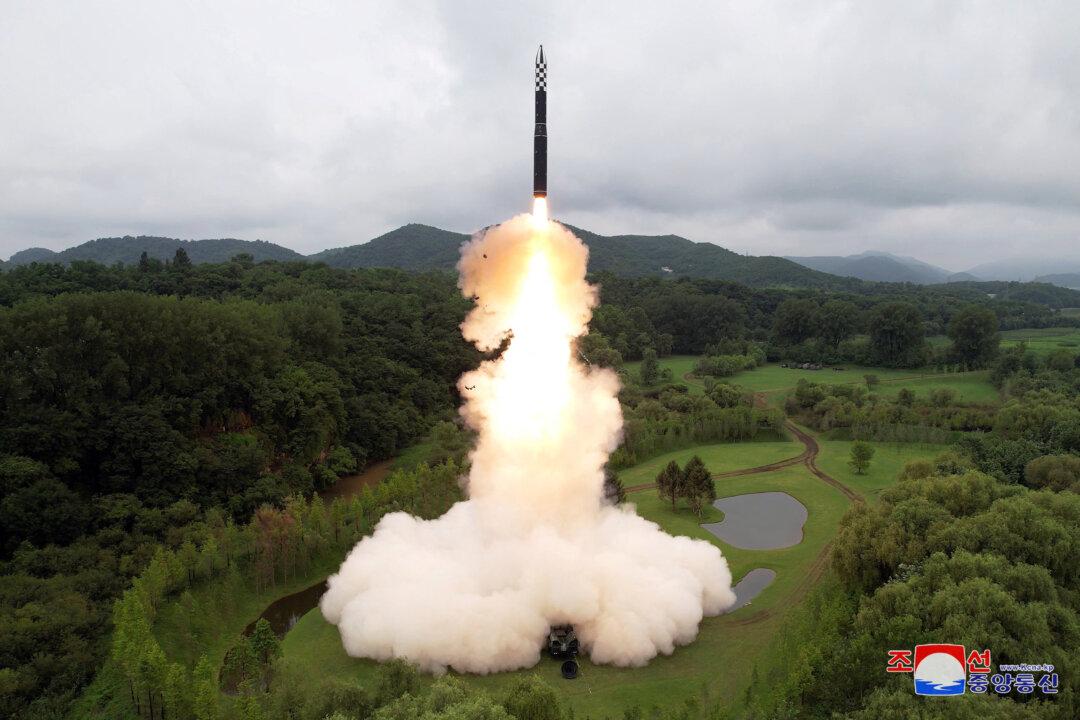NEW YORK—Wearing a gray sheath dress and bright purple cardigan, Joyce Li watched hundreds of people in yellow shirts and jackets at Gantry Square in Long Island City.
“To be in a normal society again, and experience that freedom, it’s bringing tears to my eyes,” said Li.
Li practices the spiritual meditation discipline from China, known as Falun Gong, or Falun Dafa.
In 1996 she was one of the few hundred practitioners from Wuhan, China, who participated in the first Chinese character-forming event by Falun Gong practitioners. Images from that day involve some epic memories for the peaceful practice that has suffered unimaginable brutality in China for over a decade.
On Wednesday, New York City had its first character-forming event. It brought back a flood of memories for Li.
Li continued to participate in character-forming events for the next three years. She said it was an “unparalleled atmosphere of perfect harmony.”
That was before 1999, when everything changed. In 1999 the practice of Falun Gong was banned by the Chinese Community Party (CCP), and those who persisted were persecuted.
The injustice continues to this day, with over 3,000 confirmed deaths mainly due to torture, slavery, and forced organ extraction, according to the Falun Dafa Information Center. Tens of thousands more deaths are feared, yet unconfirmed due to the complication of getting accurate human rights information out of China.
‘Righteous Fa’
Nearly a thousand people formed two large, yellow Chinese characters on the Western Queens waterfront Wednesday morning, spelling out ‘Righteous Fa,’ or ‘Rectifying the Fa.’ Fa refers to Falun Gong’s teaching of truthfulness, compassion, and tolerance.
“This has a very special meaning,” said Lijuan Ma, one of the organizers of the event, as she directed people to place markers where the expected 800-plus people would sit. “We want to show New Yorkers, and the world, that Falun Gong is wonderful, and how many people practice it.”
Falun Gong, also known as Falun Dafa, was introduced to China in 1992 by Li Hongzhi. It’s a practice of mind, body, and spirit that teaches truthfulness, compassion, and tolerance. Under former CCP leader Jiang Zemin, the regime set out on a campaign to destroy the practice, according to the Falun Dafa Information Center.
“The Jiang regime has been lying to all the world, saying it [Falun Gong] has disappeared when it has actually not,” Ma said. She gestured at the crowds of practitioners arriving in yellow matching jackets, many from around the world. “That’s totally wrong.”
Scale
The sheer logistics of such a project are impressive—such as getting a large group to quickly form neat calligraphy characters, and the amount of work that precedes it. The planning took around a month, Ma said.
“It’s very hard work,” said Qin Juan from Taiwan with a laugh. Falun Dafa practitioners from Taiwan have formed characters and pictures many times since 2002. “The effect is spectacular, and we’re honored to show the beauty of Falun Dafa to the world,” she said.
In 2005 over 5,000 people in Taiwan created a golden lotus flower and the characters for truthfulness, compassion, and tolerance. In 2012, around 7,400 people formed the image of Falun Dafa’s teacher Li Hongzhi meditating on a lotus flower, with a rainbow crowning the figure, and the characters for “Dafa” on either side.
A morning jogger from Long Island City slowed to a stop, taking in the scene with awe. “I don’t know anything about this, but I think it is beautiful,” she said.
As the practitioners sat with serene expressions, the feeling of “perfect harmony” Li experienced years ago was apparent in New York City.
Wuhan, China Was First
On her way to participate in a grand Falun Dafa parade in Manhattan, Li stopped in Long Island City to catch a glimpse of the project.
Practitioners from Wuhan first formed characters in 1996.
It was a gray and dreary weekday, Li recalled, and there was some drizzling rain. But as soon as everyone was seated, she remembered hearing a huge round of applause. Li looked up to see that the dark clouds had blown by, and there was a circle of clear sky, right above the formation.
The miraculous weather continued in 1997 and 1998, and the number of participants grew as well.
In 1999, practitioners in China could feel that the atmosphere had completely changed, Li said, and the event was scheduled earlier than usual in the year. The year before, a government investigation had found that the number of Falun Dafa practitioners had exceeded the number of CCP members.
Falun Gong’s popularity was starting to be seen as a threat to the regime, despite the practice not having any political aspirations.
Li recalled morning practice sites in parks and public spaces where hundreds of practitioners would gather to peacefully meditate. Scenes like this could be seen every few blocks in Wuhan at that time.
In 1999 over 10,000 practitioners gathered in Wuhan for the final time. They formed the four characters of Falun Dafa and three rainbows. It was pouring that day and Li recalled the rain did not let up.
“A few months later, [the regime] officially banned the practice,” Li said. Li was detained illegally and tortured for not renouncing her practice.
“I think it’s great they’re doing this in New York,” said Li, boarding a No.7 train with the practitioners leaving the site on her way to the parade.





